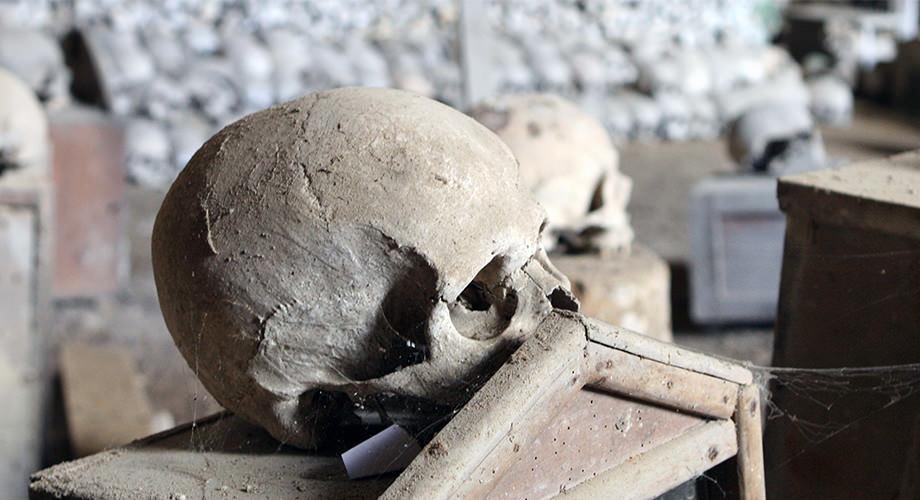
The esoteric places of Naples, between mystery, alchemy and legend.
The Neapolitan people have always had a very close link with the world of the dead to which he has almost no fear and from which, instead, he draws courage and hope for the future. The cult towards the so-called pezzentelle souls, the prayers addressed to people related to the history of the city and the profound respect for the miracle of the liquefaction of the blood of San Gennaro are just some of the rites that bear witness to this relationship.
The places considered esoteric in Naples are many among palaces, churches and squares in which they also merge magic and alchemy, places that are surrounded by mystery and legend.
San Severo Chapel
The Sansevero Chapel is linked to the figure of Prince Raimondo di Sangro to whose alchemical and esoteric abilities, according to the myth, we owe the realization of the Veiled Christ and of the Anatomical Machines. It is said that he taught the sculptor of Christ, the Sanmartino, the secret of the marbling of the veil and that he killed two servants to study the circulatory system with alchemical methods (even today the blood vessels are distinguishable). But at his death is linked the most striking esoteric episode: it is said that the Prince it was cut into pieces to be able to then reassemble in the coffin, but the relatives opened the box in advance and he, when he got up again, immediately fell down with agonizing screams.
Where is it: Via Francesco De Sanctis, 19 / 21 - 80134 Naples
The Palace of Spirits
The Palazzo degli Spiriti is located at Marechiaro and it was built in the first century BC
It owes its name to some legends about the ghosts that inhabit it, according to the beliefs of the people, and that give it a mysterious aura. It is said that in the past the fishermen at night heard a sweet melody coming from the Palace and that, from one of its arches, one could glimpse illuminated figure who played the zither.
According to other stories, in an indefinite period, some counterfeiters used it as clandestine mint, hiding the activity with white sheets on the windows. The device spread the belief about ghosts.
Where is it: Calata Ponticello to Marechiaro, 80 - 80123 Naples
Cemetery of the Fontanelle
The Fontanelle Cemetery is located in Forcella and is famous for the cult of the pezzentelle souls. It is an ancient cemetery and preserves around 40000 remains of dead people during the plague of 1656 and cholera of 1836.
It testifies the deep bond of the Neapolitans with the world of the deceased and the cited cult foresees still today theadoption of a skull (The capuzzella) of an abandoned person (pezzentella) in exchange for protection. These souls are considered bridges for the afterlife and a way to communicate with their dead. The skulls are always cleaned and adorned with flowers, hoping that, with prayer, the deceased appears in sleep.
Where is it: Via Fontanelle, 80 - 80136 Naples
Church of Santa Maria delle Anime of Purgatory in Arco
It is the church in which the Lucia's skull, A 'pezzentella soul to which believers turn to obtain a grace concerning above all love. The "skull with the veil", as also known Lucia, are linked many stories even if you do not know what is true, but almost all are based on legends.
The most famous tells that the girl, daughter of a noble, was in love with a baker, but his family contrasted their love. She, desperate and heartbroken, decided to drink some poison to kill herself. From that moment, the young women or their mothers address prayers, considering her a heroine.
Where is it: Via dei Tribunali, 39 - 80138 Naples
Blood of San Gennaro
San Gennaro is the main patron of the city and his relics are kept in the Cathedral along with his alleged blood. This is stored in two very old ampoules which are shown to the public only three times a year (the Saturday preceding the first Sunday of May, the 19 September and the 16 December), in the days when the famous miracle should take place, ie dissolution of the saint's blood.
The moment of liquefaction is fundamental for the faithful because, if it happens on time, the city and its inhabitants will continue to be protected, while if the dissolution does not happen, they would start to fear misfortunes.
Where is it: Duomo - Via Duomo, 149 - 80138 Naples
The Obelisk of the Immaculate
THEObelisk of the Immaculate in Piazza del Gesù It was built in the 18th century by the Jesuits and today it is still cloaked in legend. It is said that there are gods on the marble of the spire blasphemous symbols that recall the death and the face of a skeleton, in addition to the classical effigies present.
These forms they can only be recognized at dusk and from a certain perspective, that is, by placing oneself with the church of the New Jesus opposite. Furthermore, the veil covering the statue, if carefully observed, may seem like the hood of death. According to some, it means that in the past the Santa Muerte was venerated, one of the most important Mexican deities.
Where is it: Piazza Gesù Nuovo - 80134 Naples
Underground Naples
It is a series of underground tunnels that the Greeks were the first to dig to get the tufa for the construction of buildings. Then the Romans created large ones in the same place quarries for aqueducts.
These dungeons were used as shelters during the Second World War and it was at that time that the belief that they were spread inhabited by the spiteful spectrum of the Munaciello. In reality, the puddle that ran through those channels wore a habit and people exchanged it for a ghost, sometimes fearing it sometimes hoping it would bring them luck. Even today it is believed that from these old aqueducts the Munaciello sneaks into the houses.
Where is it: Piazza San Gaetano, 68 - 80138 Naples
Cloister of Santa Chiara
According to the legend, the ghost of Queen Giovanna wanders disconsolate in the cloister of Santa Chiara and appears every year on the day of his death, with a terrible appearance.
Giovanna was the first Queen of Naples, daughter of Charles of Anjou, devoted to leisure, entertainment and literature and it is said that it was stifled by the instigators of Charles III of Durazzo that invaded the kingdom. The mystery still hangs over his death, also because no one knows where he was buried. When it appears in the Cloister, he walks with his head bowed crying and anyone who crosses his gaze can die because she is still angry at the murder immediately.
Where is it: Cloister of Santa Chiara - Piazza del Gesù Nuovo, 18 - 80134 Naples
Piazza San Domenico Maggiore
In this square of the historic center is around the ghost of Maria d'Avalos, between the obelisk and the Sansevero Chapel.
In the 1586 the wedding between Prince Carlo Gesualdo da Venosa and his cousin Maria was celebrated, a marriage of convenience that soon brought the woman into the arms of the Duke of Carafa. Betrayal discovered the Prince had his wife killed and he exposed his body to the entrance of the Palazzo di Sansevero, then fleeing from Naples. From that moment, the inhabitants of the area say they can hear the cry of pain of the spirit of Mary that wanders sadly.
Where is it: Piazza San Domenico Maggiore - 80134 Naples
Church of Pietrasanta
It was built in the 533 by the Bishop Pomponio to counter the previous pagan rites for the goddess Diana, whose cult was followed mainly by women who were branded as witches. From this rumor was born the legend about the presence of a Devil dressed as a pig that ran in the neighboring streets scaring the inhabitants. This is why the Bishop, after having dreamed of the Madonna who gave him advice, had the church erected and every year a pig was slaughtered to chase away the evil one. It is said that there is also one in the foundations Holy stone that gives the indulgence and that Pope Evaristo is buried under the church. According to legend, every October 27, the day of his commemoration, there is a widespread feeling of well-being in the square.
Where is it: Church of Santa Maria Maggiore at Pietrasanta in Via dei Tribunali - 80138 Naples

